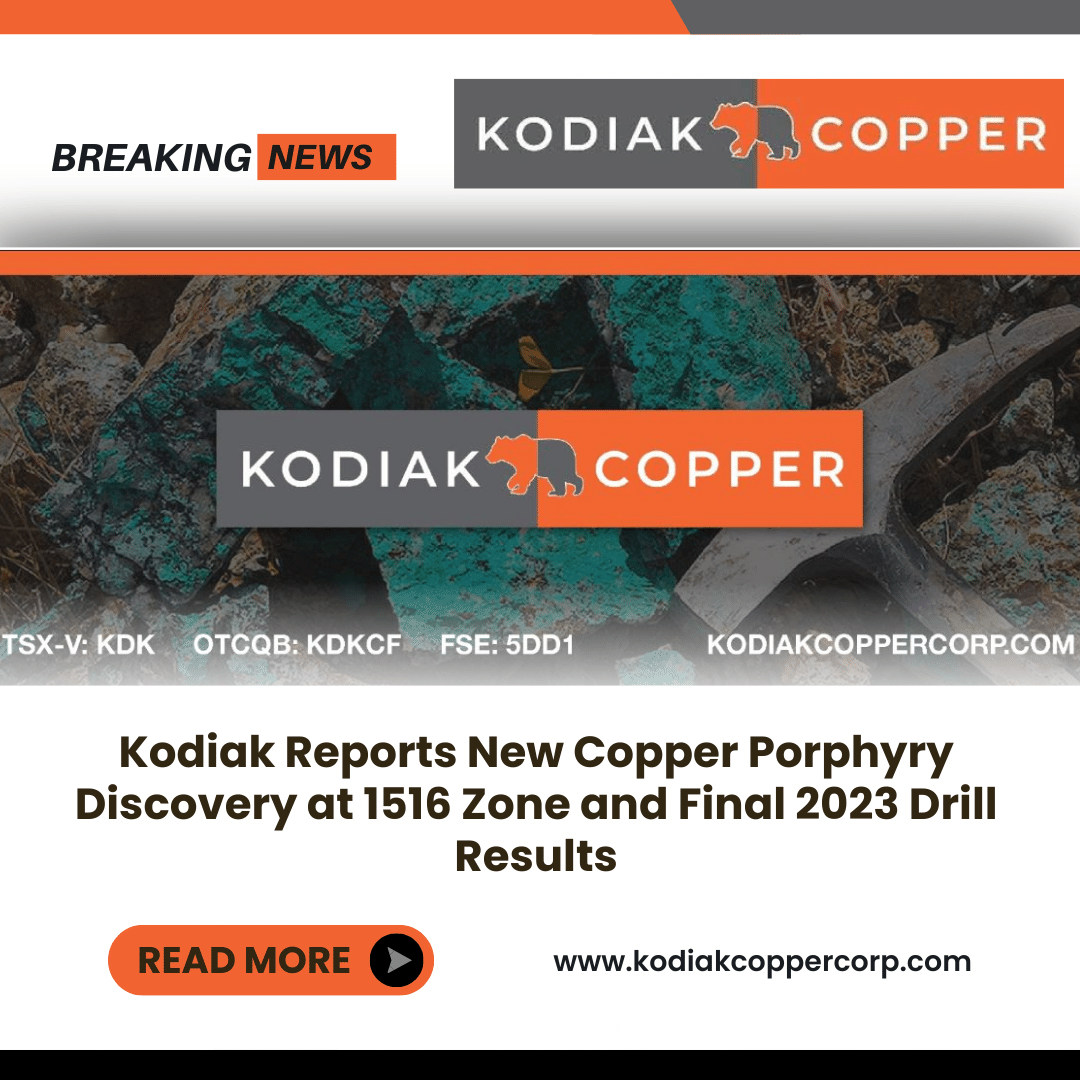Highlighted by Hole D-254 Which Intersected 120.7 M @ 3.13 g/t Au Including High Grade Intercepts Of 35.2 M @ 7.42 g/t Au and 8.4 M @ 9.65 g/t Au
- Results continue to confirm the existence and continuity of a high-grade domain within the mineralized envelope within Block 4.
- Additional high-grade intercepts include holes D-259 intercepting 7.7 m @ 14.55 g/t Au and 21.6 m @ 5.40 g/t Au and D-244 which intercepted 23.2 m @ 5.36 g/t Au (all using a 1.5 g/t Au cut-off).
- This high-grade domain remains open to depth below 600 m.
- Exploration within the western Bryan Zone continues with new Scout RC results delineating further anomalous geochemical targets for follow-up, as well as deeper RC drilling including hole R-1006 returning assays of 17.0m @ 1.71 g/t Au.
Reunion Gold Corporation (TSX-V: RGD) (OTCQX: RGDFF) is pleased to announce additional results from its resource definition drill program at Oko West. This release reports significant intervals from 34 new diamond drill holes (15,518 meters) completed in Blocks 1, 4, 5, and 6 (see Figure 1 & Figure 2) that will form part of the upcoming mineral resource estimation (MRE). Results continue to confirm broad intercepts of gold mineralization while also intersecting high-grade intervals at depth and within Block 4. These broad intercepts are highlighted by hole D-254 intercepting 120.7 m @ 3.13 grams per ton of gold (g/t Au), hole D-259 intersecting 52.7 m @ 4.55 g/t Au and hole D-271 intersecting 114.5 m @ 2.02 g/t Au.
In addition to ensuring sufficient drill density for the upcoming MRE, the drill program has also targeted high grade zones within the overall and wider mineralized envelope, as demonstrated by the higher-grade included intervals reported in Table 1 using a 1.5 g/t Au cut-off. Such higher-grade intervals and zones continue to be targeted by the Company in view of a possible underground mining scenario. The long section shown in Figure 3 illustrates the continuity of these high-grade intersects, which extend to a depth of approximately 600 m below surface and importantly remain open to expansion at depth. Note that Holes D-200 and D-203 (previously reported) intercepted gold mineralization to a depth of approximately 1,000 m below surface.
Phase 1 of the Scout Geochem drill program at the Bryan zone to the west of the project area is largely complete and has been successful in outlining three main areas of anomalous gold identified through saprolite sampling that will require further follow up (see Figure 4). This follow-up program will initially include infill scout drilling and ground geophysics, followed by conventional RC drill testing at both the High Road and North Drive targets.
Alongside the shallow Scout RC drilling program previously announced, the Company has also commenced wider spaced conventional RC drilling in selected areas within the Bryan Zone. Of the initial five holes completed and shown on Figure 4, R-1006 was drilled to a depth of 100m (beneath a Scout RC saprolite sample of 66 ppb Au) and intersected 17.0 m @ 1.71 g/t Au from 14 m depth, including 5.0 m @ 4.08 g/t Au. Further work in this area is also being planned.
Rick Howes, President, CEO and director of Reunion Gold, commented, “Activities at Oko West continue in full swing, with a combined focus on delivering a maiden resource estimate on the Kairuni zone while simultaneously delivering promising new exploration results from other areas within the project. The results from recent diamond drilling are especially important to highlight and continue to show continuity of high-grade mineralized zones at depth. For example, the 47 high-grade intersects from Blocks 1 and 4 (from 20 holes) reported a weighted average grade of 5.05 g/t Au with an estimated average true thickness of 6.7 m.
“We are also very excited to report that after just 22 months of drilling at Oko West, we intend to announce our maiden Mineral Resource Estimate (MRE) on June 13 after the close of markets and will be hosting a conference call on June 14 to provide additional information on this MRE announcement.”
The Company is also continuing with additional study activities required to deliver a Preliminary Economic Study (PEA) by year-end, which will be based on the MRE. Ongoing studies include the second phase of an environmental baseline study, as well as metallurgical testing program designed to support the PEA. The main aim of the program is to evaluate the metallurgical response of the main ore types in the deposit and develop a preliminary flowsheet design that optimizes gold recovery.
Sample collection, assaying and data management
Significant intervals in this press release have been calculated using a grade cut-off of 0.3 g/t Au, a minimum length of ten meters, and up to ten meters maximum length of consecutive internal waste. Included significant intervals have been calculated using a grade cut-off of 1.5 g/t Au, a minimum length of three meters, and up to two meters maximum length of consecutive internal waste. Gold grades are uncapped. Mineralized intersection lengths are not necessarily true widths and estimated true thickness has been calculated using an assumed plane of mineralization dipping 65° towards 095°, representative of the mineralization identified in Block 4. Complete drilling results and drill hole data are posted on the Company’s Website. Diamond drill (DD) samples consist of half of either HQ or NQ core taken continuously at regular intervals averaging 1.4 m, bagged, and labelled at the site core shed. Reverse circulation (RC) drill samples are obtained from a rotary splitter attached to a Metzke cyclone, weighed, bagged, and tagged at the drill site. All resource drilling samples are shipped to the Actlabs certified laboratory in Georgetown, Guyana, respecting best-practice chain of custody procedures. Samples from the Scout RC program and recent conventional RC samples are shipped to MS Analytical in Georgetown using the same chain-of-custody procedures. At each laboratory, samples are dried, crushed to 80% passing 2 mm, riffle split (250 g), and pulverized to 95% passing 105 μm. Coarse blanks are inserted by the Company, and are used between and following suspected high-grade intervals. Barren sand flushes are inserted by the analytical laboratory after each sample is pulverized to clean the bowl. Gold analysis is carried out through a 50 g fire assay with an atomic absorption finish. Initial assays with results above 3.0 g/t Au are re-assayed with a gravimetric finish. Samples with visible gold are additionally assayed with a metallic screen method using 1 kg of pulp. Certified reference materials and blanks are inserted at a rate of 5% of samples shipped to the laboratories. RC field duplicates and DD umpire pulp duplicates are also generated at a rate of 5% of samples. Pulp umpire duplicates are analyzed at the MSALabs certified laboratory in Georgetown. Assay data is subject to QA/QC prior to accepting into the Company database managed by an independent consultant.
Qualified Person
The technical information in this press release has been reviewed and approved by Justin van der Toorn, the Company’s VP Exploration. Mr. van der Toorn (CGeol FGS, EurGeol) is a qualified person under Canadian National Instrument 43-101.
About Reunion Gold Corporation
Reunion Gold Corporation is a leading gold explorer in the Guiana Shield, South America. In 2021 the Company made an exciting new gold discovery at its Oko West project in Guyana, where to date it has outlined continuous gold mineralization at the Kairuni zone over 2,000 meters of strike and to a depth of 600 meters. The mineralization appears to be open-pit amenable with a strong grade profile. In addition to Kairuni there are several additional priority exploration targets on the Oko West project area that the Company is exploring..
Table 1 – Significant Intervals
| Hole ID | Block | From (m) | To (m) | Downhole Interval (m) | Au Grade (g/t) | Grade x Downhole Interval (gm/t) | ETT* (m) | Cutoff** (Au g/t) |
| OKWD23-221 | 1 | 319.0 | 359.4 | 40.4 | 1.01 | 41 | 32.6 | 0.3 |
| inc | 329.0 | 332.9 | 3.9 | 3.18 | 12 | 3.1 | 1.5 | |
| inc | 340.0 | 345.0 | 5.0 | 2.56 | 13 | 4.1 | 1.5 | |
| OKWD23-237A | 6 | 207.0 | 222.9 | 15.9 | 0.37 | 6 | 0.3 | |
| and | 262.0 | 340.6 | 78.6 | 1.36 | 107 | 0.3 | ||
| inc | 298.0 | 301.0 | 3.0 | 2.93 | 9 | 1.5 | ||
| inc | 305.0 | 314.0 | 9.0 | 5.86 | 53 | 1.5 | ||
| OKWD23-238 | 4 | 639.5 | 681.0 | 41.5 | 1.26 | 52 | 36.5 | 0.3 |
| inc | 671.3 | 678.0 | 6.7 | 5.56 | 37 | 5.9 | 1.5 | |
| and | 694.0 | 707.2 | 13.2 | 0.41 | 5 | 11.7 | 0.3 | |
| OKWD23-239 | 4 | 349.0 | 367.0 | 18.0 | 0.49 | 9 | 13.5 | 0.3 |
| and | 378.0 | 392.0 | 14.0 | 0.34 | 5 | 10.5 | 0.3 | |
| and | 398.0 | 413.5 | 15.5 | 0.35 | 5 | 11.8 | 0.3 | |
| and | 426.0 | 483.0 | 57.0 | 2.77 | 158 | 43.5 | 0.3 | |
| inc | 434.5 | 441.5 | 7.0 | 3.97 | 28 | 5.3 | 1.5 | |
| inc | 452.8 | 460.9 | 8.1 | 3.16 | 26 | 6.2 | 1.5 | |
| inc | 469.7 | 476.0 | 6.4 | 13.12 | 83 | 4.9 | 1.5 | |
| OKWD23-241 | 6 | 300.6 | 316.7 | 16.1 | 0.36 | 6 | 0.3 | |
| OKWD23-242 | 4 | 557.3 | 582.1 | 24.9 | 1.29 | 32 | 22.4 | 0.3 |
| inc | 559.4 | 565.8 | 6.4 | 2.98 | 19 | 5.7 | 1.5 | |
| OKWD23-244 | 4 | 585.2 | 701.0 | 115.8 | 1.89 | 219 | 89.3 | 0.3 |
| inc | 591.4 | 604.0 | 12.6 | 3.95 | 50 | 9.6 | 1.5 | |
| inc | 614.0 | 637.2 | 23.2 | 5.36 | 124 | 17.8 | 1.5 | |
| inc | 641.0 | 644.0 | 3.0 | 2.44 | 7 | 2.3 | 1.5 | |
| OKWD23-245 | 4 | 670.2 | 695.0 | 24.8 | 0.62 | 15 | 20.6 | 0.3 |
| and | 713.0 | 728.0 | 15.0 | 2.95 | 44 | 12.8 | 0.3 | |
| inc | 721.0 | 728.0 | 7.0 | 6.02 | 42 | 6.0 | 1.5 | |
| and | 742.0 | 755.0 | 13.0 | 0.90 | 12 | 11.2 | 0.3 | |
| OKWD23-246 | 6 | 316.6 | 329.7 | 13.1 | 0.78 | 10 | 0.3 | |
| OKWD23-247 | 4 | 297.5 | 322.0 | 24.5 | 0.37 | 9 | 19.2 | 0.3 |
| and | 388.0 | 433.0 | 45.0 | 1.80 | 81 | 35.2 | 0.3 | |
| inc | 389.0 | 392.0 | 3.0 | 4.03 | 12 | 2.3 | 1.5 | |
| inc | 418.6 | 425.3 | 6.7 | 6.13 | 41 | 5.3 | 1.5 | |
| OKWD23-248 | 5 | 0.0 | 19.0 | 19.0 | 0.46 | 9 | 0.3 | |
| and | 93.2 | 127.6 | 34.4 | 0.83 | 29 | 0.3 | ||
| inc | 101.2 | 106.2 | 5.0 | 2.70 | 13 | 1.5 | ||
| OKWD23-249 | 4 | 359.0 | 369.3 | 10.3 | 0.70 | 7 | 8.7 | 0.3 |
| and | 422.6 | 438.2 | 15.7 | 2.62 | 41 | 13.4 | 0.3 | |
| and | 457.8 | 505.0 | 47.2 | 0.50 | 24 | 40.7 | 0.3 | |
| OKWD23-250 | 4 | 402.6 | 499.1 | 96.5 | 1.38 | 133 | 80.1 | 0.3 |
| inc | 406.1 | 411.0 | 4.9 | 2.52 | 12 | 4.0 | 1.5 | |
| inc | 426.9 | 430.0 | 3.1 | 2.71 | 8 | 2.6 | 1.5 | |
| inc | 437.1 | 441.1 | 4.0 | 5.54 | 22 | 3.3 | 1.5 | |
| inc | 449.1 | 452.2 | 3.1 | 3.15 | 10 | 2.6 | 1.5 | |
| inc | 460.6 | 464.5 | 3.9 | 4.27 | 17 | 3.3 | 1.5 | |
| inc | 467.0 | 479.2 | 12.2 | 2.13 | 26 | 10.1 | 1.5 | |
| OKWD23-251 | 1 | 495.0 | 530.0 | 35.0 | 1.31 | 46 | 27.1 | 0.3 |
| inc | 506.0 | 518.0 | 12.0 | 1.87 | 22 | 9.3 | 1.5 | |
| OKWD23-252 | 1 | 340.7 | 359.0 | 18.4 | 1.00 | 18 | 15.6 | 0.3 |
| OKWD23-253 | 5 | 174.5 | 222.0 | 47.5 | 1.28 | 61 | 0.3 | |
| inc | 180.0 | 183.0 | 3.0 | 9.25 | 28 | 1.5 | ||
| inc | 212.0 | 215.0 | 3.0 | 3.96 | 12 | 1.5 | ||
| OKWD23-254 | 4 | 262.4 | 383.1 | 120.7 | 3.13 | 377 | 108.3 | 0.3 |
| inc | 303.3 | 311.7 | 8.4 | 9.66 | 81 | 7.5 | 1.5 | |
| inc | 346.9 | 382.0 | 35.2 | 7.42 | 261 | 31.7 | 1.5 | |
| OKWD23-255 | 4 | 519.5 | 582.0 | 62.5 | 0.59 | 37 | 43.8 | 0.3 |
| OKWD23-256 | 5 | 104.0 | 116.0 | 12.0 | 0.67 | 8 | 0.3 | |
| and | 200.0 | 250.0 | 50.0 | 0.95 | 47 | 0.3 | ||
| OKWD23-257 | 1 | 360.0 | 377.0 | 17.0 | 0.72 | 12 | 14.0 | 0.3 |
| inc | 362.0 | 365.0 | 3.0 | 2.99 | 9 | 2.5 | 1.5 | |
| and | 396.0 | 469.8 | 73.8 | 0.95 | 70 | 61.6 | 0.3 | |
| inc | 413.0 | 420.0 | 7.0 | 3.84 | 27 | 5.8 | 1.5 | |
| OKWD23-258 | 4 | 383.0 | 479.5 | 96.5 | 1.89 | 182 | 83.0 | 0.3 |
| inc | 410.0 | 415.1 | 5.1 | 3.02 | 15 | 4.4 | 1.5 | |
| inc | 423.0 | 426.0 | 3.0 | 1.56 | 5 | 2.6 | 1.5 | |
| inc | 444.0 | 447.2 | 3.2 | 9.66 | 31 | 2.8 | 1.5 | |
| inc | 449.4 | 470.9 | 21.5 | 4.76 | 102 | 18.5 | 1.5 | |
| OKWD23-259 | 4 | 260.8 | 340.7 | 79.9 | 0.87 | 69 | 67.7 | 0.3 |
| inc | 283.2 | 286.3 | 3.1 | 2.71 | 8 | 2.6 | 1.5 | |
| inc | 319.3 | 328.5 | 9.2 | 3.08 | 28 | 7.7 | 1.5 | |
| and | 351.1 | 403.8 | 52.7 | 4.55 | 240 | 44.8 | 0.3 | |
| inc | 366.4 | 374.1 | 7.7 | 14.55 | 112 | 6.6 | 1.5 | |
| inc | 381.2 | 402.8 | 21.6 | 5.40 | 116 | 18.3 | 1.5 | |
| OKWD23-260 | 6 | 0.0 | 15.6 | 15.6 | 0.40 | 6 | 0.3 | |
| and | 71.0 | 97.0 | 26.0 | 0.96 | 25 | 0.3 | ||
| inc | 91.0 | 94.0 | 3.0 | 3.85 | 12 | 1.5 | ||
| OKWD23-261 | 1 | 361.0 | 384.0 | 23.0 | 0.72 | 17 | 20.3 | 0.3 |
| and | 404.4 | 444.3 | 39.9 | 0.76 | 30 | 35.7 | 0.3 | |
| inc | 413.0 | 417.0 | 4.0 | 1.94 | 8 | 3.6 | 1.5 | |
| OKWD23-262 | 1 | 7.5 | 19.0 | 11.5 | 0.45 | 5 | 9.2 | 0.3 |
| and | 62.0 | 79.0 | 17.0 | 0.35 | 6 | 13.5 | 0.3 | |
| OKWD23-263 | 4 | 355.0 | 371.7 | 16.7 | 1.36 | 23 | 14.1 | 0.3 |
| and | 383.4 | 436.7 | 53.3 | 2.85 | 152 | 45.6 | 0.3 | |
| inc | 394.7 | 404.3 | 9.7 | 3.48 | 34 | 8.2 | 1.5 | |
| inc | 407.3 | 417.0 | 9.8 | 8.65 | 84 | 8.3 | 1.5 | |
| inc | 428.0 | 431.6 | 3.6 | 4.18 | 15 | 3.1 | 1.5 | |
| OKWD23-264 | 6 | 20.0 | 39.0 | 19.0 | 0.33 | 6 | 0.3 | |
| and | 81.0 | 142.0 | 61.0 | 0.95 | 58 | 0.3 | ||
| inc | 89.0 | 101.0 | 12.0 | 1.82 | 22 | 1.5 | ||
| inc | 126.5 | 133.0 | 6.5 | 2.95 | 19 | 1.5 | ||
| OKWD23-265 | 1 | 18.0 | 32.0 | 14.0 | 0.33 | 5 | 10.5 | 0.3 |
| OKWD23-266 | 1 | 360.8 | 379.0 | 18.2 | 0.76 | 14 | 16.2 | 0.3 |
| OKWD23-267 | 1 | 120.0 | 124.0 | 4.0 | 2.66 | 11 | 3.7 | 1.5 |
| OKWD23-268 | 4 | 456.2 | 472.2 | 16.1 | 1.21 | 19 | 11.5 | 0.3 |
| and | 486.0 | 556.0 | 70.0 | 2.44 | 171 | 50.9 | 0.3 | |
| inc | 498.0 | 503.0 | 5.0 | 6.56 | 33 | 3.6 | 1.5 | |
| inc | 509.6 | 528.0 | 18.4 | 5.88 | 108 | 13.4 | 1.5 | |
| inc | 534.0 | 538.0 | 4.0 | 2.03 | 8 | 2.9 | 1.5 | |
| OKWD23-269 | 4 | 455.4 | 529.0 | 73.6 | 1.76 | 130 | 60.7 | 0.3 |
| inc | 479.3 | 482.5 | 3.2 | 1.75 | 6 | 2.6 | 1.5 | |
| inc | 496.4 | 507.0 | 10.6 | 5.59 | 59 | 8.8 | 1.5 | |
| inc | 521.0 | 524.5 | 3.5 | 6.14 | 22 | 2.9 | 1.5 | |
| OKWD23-271 | 4 | 224.5 | 339.0 | 114.5 | 2.02 | 232 | 99.0 | 0.3 |
| inc | 265.5 | 271.6 | 6.2 | 1.59 | 10 | 5.3 | 1.5 | |
| inc | 307.3 | 329.6 | 22.3 | 4.43 | 99 | 19.5 | 1.5 | |
| inc | 333.0 | 336.0 | 3.0 | 2.74 | 8 | 2.6 | 1.5 | |
| OKWD23-273 | 1 | 277.0 | 298.0 | 21.0 | 0.30 | 6 | 19.0 | 0.3 |
| and | 326.0 | 360.0 | 34.0 | 0.81 | 28 | 30.9 | 0.3 | |
| inc | 327.0 | 331.0 | 4.0 | 1.67 | 7 | 3.6 | 1.5 | |
| OKWR23-1006 | Bryan Z. | 14.0 | 31.0 | 17.0 | 1.71 | 29 | 0.3 | |
| inc | 14.0 | 19.0 | 5.0 | 4.08 | 20 | 1.5 | ||
| * Estimated True Thickness (“ETT”) based on an average dip / dip direction of -65° / 095° to represent the orientation of the mineralized zone in Block 4. ETT only calculated for Blocks 1 and 4. | ||||||||
| ** Significant intervals calculated using a 0.3 g/t Au cutoff, 10m minimum length and 10m maximum consecutive internal waste. Included intervals calculated using a 1.5 g/t Au cutoff, 3m minimum length and a 2m maximum consecutive internal waste. | ||||||||
Figure 1 – Plan map of holes mentioned in this press release in relation to Block outlines at surface and location of long-sections (inclined to the east)
Link to Figure 1 : https://www.reuniongold.com/230601-pr?lightbox=dataItem-kip1legb
Figure 2 – Combined inclined long section showing reported significant intervals from this press release in relation to Block locations.
Link to Figure 2: https://www.reuniongold.com/230601-pr?lightbox=dataItem-kip1qnce
Figure 3 – Inclined section through Block 4 showing high grade intersects reported in this press release (note only intervals with Au grade >4.0 g/t Au shown). Intervals displayed in the format of “downhole interval (m) @ g/t Au grade”.
Link to Figure 3: https://www.reuniongold.com/230601-pr?lightbox=dataItem-kip1qncg
Figure 4 – Scout RC results and coverage to date, with reference to the location of the Kairuni zone discovery and conventional RC drill collars as noted in this press release. Block numbers noted in blue text in the format B#, for reference.
Link to Figure 4: https://www.reuniongold.com/230601-pr?lightbox=dataItem-lidhftu4



